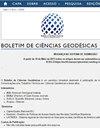GPS卫星上原子钟的误差行为
IF 0.5
Q3 Earth and Planetary Sciences
引用次数: 2
摘要
GNSS定位获得的信号传输和位置质量直接取决于时间控制。卫星上的原子钟负责这种控制。在本研究中,利用RINEX导航和观测文件中的伪距、卫星半长轴数据和卫星时钟误差的校正参数,研究了GPS的卫星时钟误差。根据这些数据,使用铷和铯时钟的IGS数学模型计算卫星的时钟误差,然后应用调整技术来估计时钟校正的新参数。对于铯原子钟,对数学模型中的周期部分进行了调整。将调整后的校正参数应用于IGS和自适应模型中;最后,将结果与clk_30s文件中的IGS数据进行了比较。所进行的实验表明,铯卫星的时钟误差提高了50厘米。此外,研究得出结论,卫星的时钟误差并不取决于数据收集站和设备的天线。本文章由计算机程序翻译,如有差异,请以英文原文为准。
ERROR BEHAVIOR OF ATOMIC CLOCKS ABOARD GPS SATELLITES
The signal transmission and position quality obtained by GNSS positioning directly depends on the time control. The atomic clocks aboard the satellites are responsible for this control. In this research, the satellites clock errors of GPS are studied, using data from the pseudorange, the satellite semi-major axis and the correction parameters of the satellites’ clock errors found in the RINEX navigation and observation files. From these data, the satellites’ clock errors are calculated using the IGS mathematical model for rubidium and cesium clocks, and then an adjustment technique is applied in order to estimate the new parameters of the clock corrections. For cesium atomic clocks, the periodic part of the mathematical model was adapted. The correction parameters adjusted were applied in the IGS and the adapted model; finally, the results were compared with the IGS data from the clk_30s file. The experiments carried out show an improvement of 50 cm in the cesium satellites’ clock errors. In addition, the research concludes that the satellites’ clock errors do not depend on the station where the data were collected and the equipment’s antenna.
求助全文
通过发布文献求助,成功后即可免费获取论文全文。
去求助
来源期刊

Boletim De Ciencias Geodesicas
Earth and Planetary Sciences-General Earth and Planetary Sciences
CiteScore
1.70
自引率
20.00%
发文量
10
审稿时长
3 months
期刊介绍:
The Boletim de Ciências Geodésicas publishes original papers in the area of Geodetic Sciences and correlated ones (Geodesy, Photogrammetry and Remote Sensing, Cartography and Geographic Information Systems).
Submitted articles must be unpublished, and should not be under consideration for publication in any other journal. Previous publication of the paper in conference proceedings would not violate the originality requirements. Articles must be written preferably in English language.
 求助内容:
求助内容: 应助结果提醒方式:
应助结果提醒方式:


